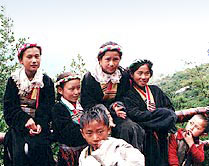 A high-ranking official of Tibetan origin Wednesday rejected foreign media reports of "ethnic Han people's assimilation of Tibet" as an "absurdity."
A high-ranking official of Tibetan origin Wednesday rejected foreign media reports of "ethnic Han people's assimilation of Tibet" as an "absurdity."
Legqog, chairman of the Tibet Autonomous Region, noted that ethnic Tibetans have always made up more than 90 percent of the region's total population.
The chairman was responding to reports that the Chinese central government had recently relocated a large number of Han people to Tibet and that ethnic Tibetans would soon become a minority in their regional capital, Lhasa. No such "immigration" has ever existed, said Legqog.
Ethnic Tibetans account for 92.2 percent of the total population of the Tibet Autonomous Region, which is 2.6163 million according to the fifth national census conducted on November 1, 2000.
Ethnic Tibetans number 2.4111 million in Tibet, ethnic Han people number 155,300, and other ethnic groups 49,900.
"Ethnic Tibetans are, as they have always been, the bulk of the local population and the majority ethnic group of Tibet," said Legqog.
The chairman said the apparent decline in the proportion of ethnic Tibetans is due to a technical problem in the last national census. He acknowledged that different statistical methods and standards were applied in the fifth national census compared to the previous versions.
"As a matter of fact, the census takers did not count Tibetans who were not in Tibet at that time but they did count those who had come to Tibet and stayed there for half a year or longer," he explained.
"So the proportion appears smaller but, in fact, it is still above 95 percent," Legqog said.
Tourists from overseas may have noticed that today's Tibetans, like people of other ethnic groups in China, have a more varied choice in terms of fashion. "We love gorgeous traditional Tibetan robes and we like modern suits and ties and popular sportswear, too," said the Tibetan leader.
Members of other ethnic groups have also expressed an interest in traditional Tibetan garments and some wear such clothes. "So it is really hard to tell who is Tibetan and who is Han by simply judging from what they wear," he said.
In the process of Tibet's large-scale construction, the central government has selected and sent some outstanding officials and professionals from other parts of the country to work in Tibet.
"These able and competent people have helped promote the development of Tibet through their diligent work," Legqog said.
The family-planning policy adopted in 1975 by the central government targets mainly people of Han nationality coming from elsewhere in China, he said. The government of the Tibet Autonomous Region in 1985 began encouraging Tibetan officials and white-collar and blue-collar workers to have two children with an appropriate interval between each in the light of the specific local conditions in Tibet.
(Xinhua News Agency September 5, 2002)
|

